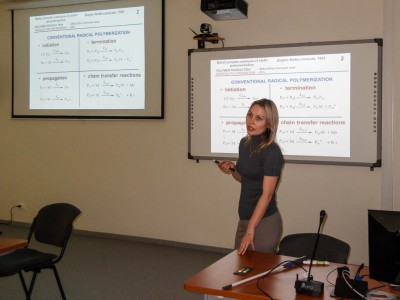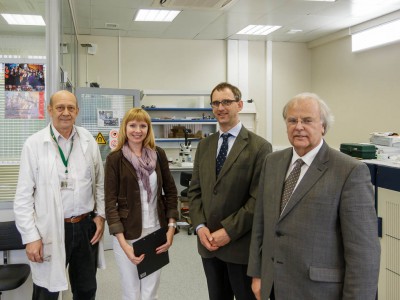The second part of the G-RISC workshop “NMR as interdisciplinary tool for the study of non-covalent interactions” took place on 16 and 18 June.
The program was as follows:
• Regina Islamova “Transition Metal-Catalyzed polymerisation: NMR and EPR study”;
• Roman Yakovenko “NMR study of protonation of carbonyl compounds (fluorinated enones and furanes) in Brønsted superacids”;
• Konstantin Luzyanin “Combining NMR and MS tools for study of nano clusters in solution”;
• Kirill Kulish “Zinc(II)-Mediated Generation of 5-amino-1,2,4-oxadiazoles from amidoximes and cyan amides”
P. R. Golubev, A. S. Pankova, M. A. Kuznetsov
“Transition-Metal-Free Approach to 4-Ethynylpyrimidines via Alkenynones”
Eur. J. Org. Chem. 2014, 3614-3621
DOI: 10.1002/ejoc.201402045

A practical approach to the synthesis of 4-ethynylpyrimidines by the condensation of arylamidines with 2-aryl-1-ethoxy-5-(trimethylsilyl)pent-1-en-4-yn-3-ones has been developed. As these latter ketones are easily accessible from bis(trimethylsilyl)acetylene and arylacetyl chlorides, the regioselective condensation reported herein provides a facile access to both TMS-protected and unprotected 4-ethynylpyrimidines in yields of up to 85%.
M. Popova, D. Michel
«Behavior of Sodium Lauroyl Sarcosinate in Solution and Binary Mixtures by Means NMR»
Applied Magnetic Resonance 2014, 45, 353-364
DOI 10.1007/s00723-014-0531-9

Measurements of the 1H and 13C chemical shifts as well as 1H spin–lattice relaxation times of sodium lauroyl sarcosinate (SLAS) in aqueous solutions and mixed binary systems with co-surfactants were carried out at various concentrations. It will be shown that changes in the chemical shifts for the N–CH2 groups in SLAS with increasing surfactant concentration can be used to estimate the ratio pcis /ptrans of cis- and trans-isomers. The relative fraction p trans of molecules in trans-configurations increases the most in a narrow concentration range 0.007–0.034 mol/l, i.e., at the transition from the monomeric state to the micelle. The ratio pcis /ptrans asymptotically decreases with increasing concentration, reaching a constant value at concentrations significantly above the critical micelle concentration. Thus, the ratio can be related to the process of micellization. If micellization takes place, the cis-isomer starts to transform into trans-isomer because the trans-isomer is more favorable in micelles. Because of the smaller cross section of the polar group region, the trans-conformation can be more easily incorporated into the micelle. In summary, the occurrence of micellar aggregates at low SLAS concentration in mixed systems can be clearly inferred from the nuclear magnetic resonance spectra.
We participated in a Central European School on Physical Organic Chemistry, which was held in Psheseka (Poland) 26-30.05.2014
with a lecture
P.M. Tolstoy, S.A. Pylaeva, B. Koeppe, E.Yu. Tupikina, C. Allolio, D. Sebastiani, G.S. Denisov, H.-H. Limbach
«Aprotic Polar Solvent Dynamics and Proton Tautomerism in Strong Hydrogen Bonds. NMR, UV-vis and MD Study»
and a poster
M.A. Vovk, A. Kwocz, T. Kozlecki, P. Tretyakov, P.M. Tolstoy, A. Filarowski
«NMR study of hindered internal rotation in β-hydroxynaphthylamides».








